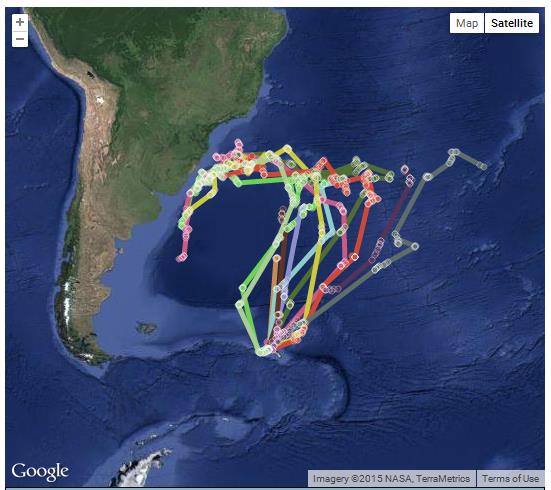NEWS STORY: Petrels followed on feeding trips
Petrels tracked across the Oceans
Staff at British Antarctic Survey (BAS) are following the journeys of White-chinned Petrel fledglings as they make their first journeys over the South Atlantic Ocean in search of food. The birds have been fitted with small satellite transmitters and the location data are processed at BAS’ head office in Cambridge, UK. The devices were attached just before the chicks fledged on Bird Island, South Georgia, in early April.
The White-chinned Petrel is the most common bird recorded as fisheries bycatch in the Southern Ocean. South Georgia is home to more than half the world’s population. Although measures have been taken to reduce the risks, the bird is still regularly killed in longline and trawl fisheries. It is listed as Vulnerable on the IUCN Red List of Threatened Species. At Bird Island there was a decrease of 28% in nesting burrow occupancy between the 1970s and 1990s.
The tagging will enable scientists to monitor the routes they take as they search for food sources. This has not been done before with juveniles. Their movements are being added to a map which is updated daily.
The greatest risk to these birds lies on the Patagonian shelf where most of them seem to be heading to and where there is intensive fishing. The distances covered in the first few weeks after fledging are in excess of 9000 kilometres.
Funding for the devices was obtained from the South Georgia fisheries licence fees, and this tracking is part of a wider study that involves attaching geolocators to birds to track non-breeding movements and at-sea activity patterns of adults at South Georgia and in the Falkland Islands.
10 facts about White-chinned petrels;
- The word “petrel” originates from the Latin name for St Peter and is a reference to the ability of the bird to hover just above the waves giving an appearance of walking on water, as St. Peter is said to have done in the Bible.
- These birds nest in burrows
- They feed mainly on krill, fish and squid
- The global population is estimated to be around 3 million and half of that is believed to be on South Georgia
- Around thirty thousand are thought to die each year through long line and trawl fishing
- They are sooty black in colour with variable amounts of white on the throat and chin
- Adult birds travel up to 8000 km on feeding trips during the breeding season
- They live to more than 30 years of age
- Both sexes help dig the burrow, incubate the egg and feed the chick
- Their wing span can reach 134–147 cm (53–58 in)
